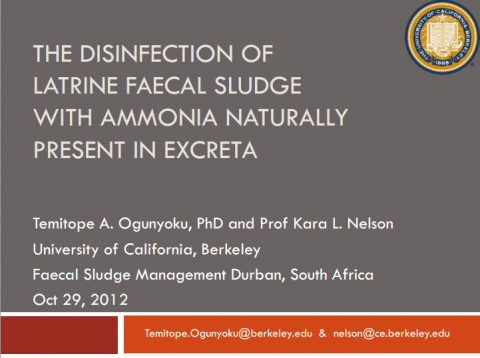Safe sludge: The disinfection of latrine faecal sludge with ammonia naturally present in excreta - Various documents on results from research grant
Nelson, K. (2013)

Published in: 2013
Publisher:
Regents of the University of California at Berkeley, USA
Author:
Nelson, K.
Uploaded by:
SuSanA secretariat
Partner profile:
common upload
11710 Views
274 Downloads
Content - Summary
This library entry contains background documents for a grant that Kara Nelson is leading and which is funded by the Bill and Melinda Gates Foundation.
Further information and a discussion is available on the SuSanA discussion Forum, see link below.
Short description of the project:
Safe Sludge is a process for disinfecting faecal sludge in latrines by converting the ammonia naturally found in urine and faeces into a powerful disinfectant with an alkaline additive that will raise the pH level. By killing pathogens immediately and turning waste into “safe sludge,” all subsequent activities required for faecal sludge management can become safer. The project proved that urea from urine and urease from faeces produce ammonia after at least 2 hours of contact. Additionally, a toilet that applies the Safe Sludge process was designed, using a two-step system. In the first step urine and faeces mix and are stored for 2 hours to produce ammonia. In the second step, the waste is collected in a 10-gallon collection bin containing a lime solution, which raises the pH of the waste to 12, converting ammonia to a disinfectant. The safe sludge can then be converted to fertilizer or fuel.
Ammonia (NH3) is a powerful chemical disinfectant that previous research shown to inactivate pathogens (i.e. viruses, bacteria, protozoan cysts, and helminths eggs). NH3 can be produced from mixing urine, which contains urea, and feces, which contains the enzyme urease. Urease is a catalyst that converts (via hydrolysis) urea into NH3.
It was determined that a 4-hour contact time between the feces and urine was needed to convert urea to ammonium using the urease enzyme present in feces. Importantly, the urease enzyme was not active above ~ pH 9. As a result, the Safe Sludge disinfection process required two stages, a 4-hour contact time for urine and feces (to hydrolyze urea) followed by the addition of an alkalinizing agent, calcium hydroxide (Ca(OH)2), to produce NH3.
Goal(s): The goal of this project is to disinfect excreta in latrines by converting the ammonia naturally found in urine and faeces into a powerful disinfectant by adding an alkalinizing agent to raise the pH level.
Objectives (or activities or key research components):
Treat excreta at the point of collection by harnessing ammonia from human waste, compatible with downstream treatment and resource recovery.
Future work:
Field testing of Safe Sludge Approach, started in November 2nd, 2012. Partner is Sanergy in Nairobi, Kenya. The goals were 1) to determine the minimum amount of urine needed to be mixed with faeces to create the NH3 concentrations needed for disinfection and 2) to retrofit an existing Sanergy toilet (Shared urine diverting toilets) to divert a portion of the urine into the feces receptacle to see if we get comparable results.
General future goals are to apply Safe Sludge Approach that was developed during Phase 1 to:
1. Further develop the household pHfree Loo
2. Adapt pHfree Loo to shared toilets
3. Develop chemical additives to disinfect waste in existing pit latrines
Research or implementation partners: Sanergy in Nairobi, Kenya
Authors: Temitope, A. O., Nelson, K. L.
Start and end date: May 1, 2011 through May 15, 2013
+++++++++++
Documents available for download below:
1 - The disinfection of latrine faecal sludge with ammonia naturally present in excreta (presentation at FSM2 Conference in Durban, South Africa, Oct. 2012)
2 - Tarpeh, W. A. (2015): Comparing ion exchange and electrochemical nitrogen recovery from source-separated urine (presentation at FSM3 Conference in Hanoi, January 2015)
Bibliographic information
Nelson, K. (2013). Safe sludge: The disinfection of latrine faecal sludge with ammonia naturally present in excreta - Various documents on results from research grant. Regents of the University of California at Berkeley, USA
Filter tags
English Faecal sludge treatment processes Fundamental research and engineering Sub-Saharan Africa














